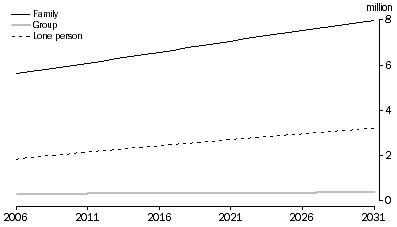INCREASE IN NUMBER OF HOUSEHOLDS
The number of households in Australia is projected to increase from 7.8 million in 2006 to between 11.4 and 11.8 million in 2031 (Series I and Series III respectively). This is an increase of between 3.7 and 4.0 million households, or 47% to 52%. Over the same period, Australia's population is projected to increase by 39%, from 20.7 million people to 28.8 million people.
Family households are projected to show the greatest numeric increase of all households over the projection period, and to remain the most prevalent household type in Australia. The number of family households is projected to increase by between 2.3 and 2.4 million households, from 5.6 million in 2006 to between 7.9 and 8.0 million in 2031.
Although family households show the greatest numeric increase, lone person households are projected to show the greatest percentage increase over the 25-year projection period. The number of lone person households is projected to increase by between 63% and 91%, or 1.2 to 1.7 million households. This is an increase from 1.9 million households in 2006 to between 3.0 and 3.6 million households in 2031. This is mainly related to the ageing of the population and the fact that older women, in particular, are more likely to live alone than other people.
1.1 Projected number of households, Household type
- Series II

Average household size
The average household size in Australia is projected to decline from 2.6 people per household in 2006 to between 2.4 and 2.5 people per household in 2031. In 2016, Australia's household size (2.5) is projected to be the same as Japan and New Zealand (both 2.5), and larger than England (2.2) and Scotland (2.1).
 Print Page
Print Page
 Print All
Print All